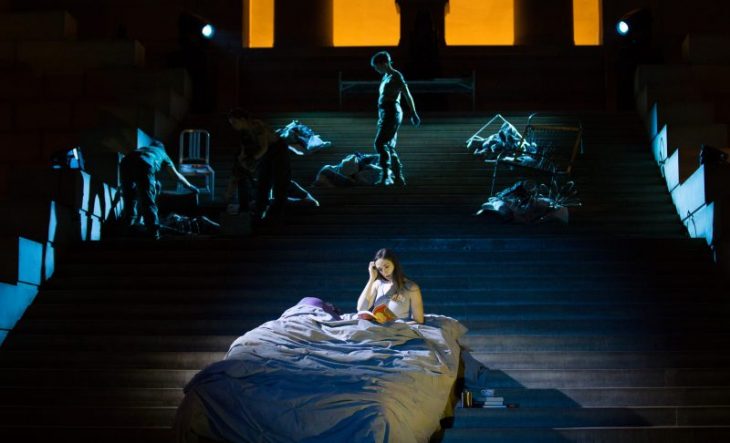
War Stories, operas by Claudio Monteverdi and Lembit Beecher at the Philadelphia Museum of Art as part of Opera Philadelphia’s O17 Festival, September 2017.
War Stories is a clever pairing of two music dramas dealing with battles, presented by Opera Philadelphia as part of its O17 Festival. The two separate compositions are staged in adjacent areas of the Philadelphia Museum of Art — its stone cloisters and its Great Stair Hall — next to displays of medieval military armaments.
Adding to the shrewdness of the planning, each of the pieces is scored for the same group of ancient instruments: harpsichord, theorbo, baroque oboe and string quartet, and sung by the same cast.
The first piece is Il combattimento di Tancredi e Clorinda (The Battle of Tancredi and Clorinda) by Claudio Monteverdi, which actually is part of a madrigal — a polyphonic song — that Monteverdi wrote for performance in a church. The music lasts a mere 20 minutes. Here it is performed in the museum’s cloister from an abbey church at Saint Laurent in central France, amidst arches, pillars and low ceilings. It’s inspiring to hear Monteverdi’s pioneering use of tremolos and pizzicatos in which the players set down their bows and use two fingers to pluck the strings.
Tancredi is a knight of the First Crusade (circa 1096) attempting to conquer Jerusalem. He loves a woman of the enemy’s army, Clorinda, and meets her on a battlefield. Because they are wearing armor — in this staging, wearing masks — they do not recognize each other. Here, at night, it’s even more believable that the two do not realize their identities. Most of the singing comes from a narrator whose text was divided between tenor Samuel Levine and mezzo Abigail Levis. The tender duet of the lovers who finally recognize one another was plaintively sung by baritone Craig Verm and mezzo Cecelia Hall.
During an intermission the audience walks through the dimly-lit corridors of the museum, and then comes the contemporary I Have No Stories To Tell You, with music by Lembit Beecher and libretto by Hannah Moscovitch, about a female soldier’s return home from an assignment on a battlefield (un-named but presumably in the Middle East).
The pairing was first assembled at New York’s Metropolitan Museum of Art Medieval Sculpture Hall in 2014, when I Have No Stories received its world premiere.
The two compositions share a theme of disguised identity or changed identity, and of struggles to communicate. The new opera takes awhile to grab our attention. It’s dramatically necessary to show that the veteran, Sorrell (Cecelia Hall), has repeated nights when she can not sleep, leaves her husband (Craig Verm) in bed and paces the floors of their home. Nevertheless, there should be a way to portray this without repeating those incidents three times.
Eventually, the opera reaches a disturbing climax when we see that Sorrell was traumatized when she was raped by a comrade (Samuel Levine) with whom she had an emotional relationship. Moreover, moments before the rape, she told that soldier how she missed her husband and thought of him constantly. The possibility exists that, during the assault, she thought about her husband back home, and that may have added a feeling of guilt.
The provocative story is revealed, layer by layer, by librettist Moscovitch. Her high-flown poetic language is intermixed with some blunt everyday words.
Beecher accomplished a great deal in using ancient instruments with modern technique. His spare and subtle orchestrations express the unresolvable issues of war-induced stress disorder. He used Monteverdi’s instruments without imitating; the only similarity was his use of a ground bass to provide a dark underpinning.
Robin Guarino directed both operas. The Monteverdi gripped us with its close-up view of battle; the modern work was more diffuse as its action moved up and down the museum’s stairs. Gary Thor Wedow conducted both, presenting two very different soundscapes. Kaye Voyce designed the costumes, Mary Eleanor Stebbins the lighting, and Daniel Perelstein the sound.